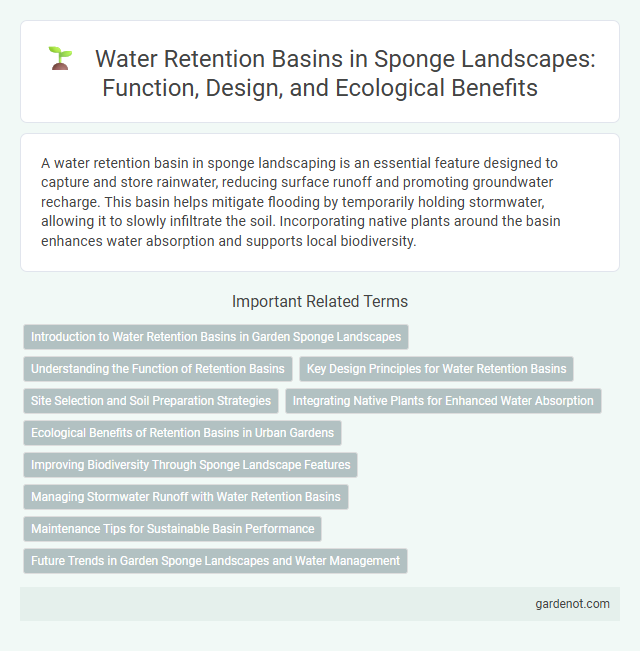A water retention basin in sponge landscaping is an essential feature designed to capture and store rainwater, reducing surface runoff and promoting groundwater recharge. This basin helps mitigate flooding by temporarily holding stormwater, allowing it to slowly infiltrate the soil. Incorporating native plants around the basin enhances water absorption and supports local biodiversity.
Introduction to Water Retention Basins in Garden Sponge Landscapes
Water retention basins in garden sponge landscapes are designed to capture and store stormwater runoff, promoting groundwater recharge and reducing soil erosion. These basins enhance the landscape's ability to manage excess water by temporarily holding rainwater, allowing it to infiltrate slowly into the soil. Incorporating water retention basins supports sustainable urban drainage and improves plant health by maintaining consistent moisture levels.
Understanding the Function of Retention Basins
Water retention basins are engineered structures designed to capture and temporarily store stormwater runoff, reducing flood risks and minimizing soil erosion. These basins promote groundwater recharge by allowing stored water to slowly infiltrate into the soil, improving overall watershed health. Effective retention basins enhance urban resilience by controlling peak runoff rates and improving water quality through sediment and pollutant settlement.
Key Design Principles for Water Retention Basins
Water retention basins are engineered landscapes essential for managing stormwater by temporarily storing runoff and facilitating gradual infiltration. Key design principles include optimizing basin size to accommodate peak runoff volumes, incorporating vegetated slopes and bottom liners for erosion control and seepage prevention, and ensuring outlet structures regulate discharge rates to prevent downstream flooding. Integrating native plant species enhances water quality through natural filtration and supports local biodiversity within the sponge landscape framework.
Site Selection and Soil Preparation Strategies
Optimal site selection for a water retention basin prioritizes low-lying areas with natural depressions to maximize water capture and minimize runoff. Soil preparation strategies involve enhancing permeability through organic matter incorporation and mechanical aeration to improve infiltration rates while ensuring soil stability to prevent erosion. Combining these practices supports efficient water storage and prolonged retention within sponge landscape systems.
Integrating Native Plants for Enhanced Water Absorption
Integrating native plants in water retention basins significantly improves water absorption by leveraging their deep root systems and natural adaptation to local soil conditions. These plants increase soil permeability and reduce surface runoff, promoting efficient groundwater recharge. Utilizing native vegetation also supports biodiversity and enhances the overall resilience of the sponge landscape ecosystem.
Ecological Benefits of Retention Basins in Urban Gardens
Water retention basins in urban gardens significantly enhance biodiversity by providing habitats for aquatic plants, insects, and birds, promoting ecosystem balance. These basins improve groundwater recharge and reduce stormwater runoff, mitigating urban flooding and pollution. By filtering pollutants and sediment, retention basins support healthier soil and water quality, boosting overall urban environmental resilience.
Improving Biodiversity Through Sponge Landscape Features
Water retention basins in sponge landscapes enhance biodiversity by providing habitats for diverse aquatic and terrestrial species, promoting ecosystem resilience. These basins regulate water flow and improve soil moisture, supporting native vegetation growth and attracting pollinators and wildlife. Integrating water retention basins improves ecological connectivity and fosters sustainable urban and rural environments through natural water management.
Managing Stormwater Runoff with Water Retention Basins
Water retention basins play a critical role in managing stormwater runoff by temporarily holding excess rainwater and reducing flooding risks in urban areas. These basins improve water quality by allowing sediments and pollutants to settle before the water slowly infiltrates into the ground or is released downstream. Properly designed retention basins contribute to groundwater recharge, mitigate erosion, and support the ecological health of surrounding landscapes.
Maintenance Tips for Sustainable Basin Performance
Regular inspection and removal of debris are essential for maintaining optimal water retention basin performance. Vegetation management, including trimming and replanting native species, helps prevent erosion and supports natural filtration. Periodic sediment removal ensures storage capacity is preserved, promoting sustainable stormwater management in sponge landscapes.
Future Trends in Garden Sponge Landscapes and Water Management
Future trends in sponge landscape design emphasize advanced water retention basins integrated with smart irrigation systems to optimize rainwater harvesting and reduce runoff. Innovations include permeable materials and native vegetation to enhance groundwater recharge and support urban sustainability. These developments aim to transform gardens into resilient ecosystems that efficiently manage stormwater while promoting biodiversity.
Water retention basin Infographic

 gardenot.com
gardenot.com